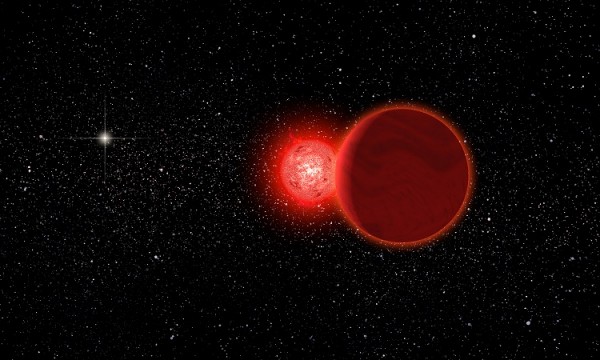Close Call: Star in Close Encounter with our Solar System 70,000 Years Ago
| Ana Verayo | | Feb 18, 2015 07:47 AM EST |
(Photo : Michael Osadciw/University of Rochester.) Artist's conception of Scholz's star and its brown dwarf companion (foreground) during its flyby of the solar system 70,000 years ago.
Astronomers have discovered a new star that apparently passed though the outskirts of our solar system some 70,000 years ago.
The star most likely sailed through the Oort cloud, which is made up of a distant cloud of comets and asteroids. Its closest fly-by came to within 0.8 light years from Earth, according to astronomers from the U.S., South Africa and Chile.
Like Us on Facebook
In astronomical terms, it's considered as a close call. The nearest neighboring star from our solar system, Proxima Centauri, is at a safe distance of 4.2 light years away from us.
This star, also called a "Scholz's star", left astronomers curious about its place in the galaxy despite being relatively near our solar system. This star is also unique as it moves in a bizarre, ultra slow motion manner across the sky called a tangential motion.
Lead author Eric Mamajek a professor of astronomy and physics from the University of Rochester, said most stars near our system produce larger tangential motions. This indicates this star's slow tangential motion could suggest it's either moving towards us or away from us.
Fortunately, further evidence and observations confirmed the star is moving away from the solar system, Mamajek adds. Using the Southern African Large Telescope and the Magellan telescope in Chile's Las Campanas Observatory, astronomers plotted its past trajectory and measured the star's current velocity.
Mamajek also notes the close flyby of Scholz's star did almost little impact to the Oort cloud. A star that usually passes through those regions in the cloud can trigger a comet shower directed at the inner solar system. He also believes other Oort cloud asteroid perturbers can be lurking nearby other stars.
Scholz's star is a low mass red dwarf that's part of a binary system and has a brown dwarf partner. Brown dwarfs are considered failed stars since their masses are too low to produce the hydrogen fusion needed to become a full blown star. They're still more massive than gas giants such as Jupiter.
This study was published in the Astrophysical Journal Letters.
Tagsscholz star, red dwarf star, Oort Cloud, star close call close encounter solar system, Close Call: Star 0.8 Light Years Away Made Close Encounter with our Solar System
©2015 Chinatopix All rights reserved. Do not reproduce without permission
EDITOR'S PICKS
-

Did the Trump administration just announce plans for a trade war with ‘hostile’ China and Russia?
-

US Senate passes Taiwan travel bill slammed by China
-

As Yan Sihong’s family grieves, here are other Chinese students who went missing abroad. Some have never been found
-

Beijing blasts Western critics who ‘smear China’ with the term sharp power
-

China Envoy Seeks to Defuse Tensions With U.S. as a Trade War Brews
-

Singapore's Deputy PM Provides Bitcoin Vote of Confidence Amid China's Blanket Bans
-

China warns investors over risks in overseas virtual currency trading
-

Chinese government most trustworthy: survey
-

Kashima Antlers On Course For Back-To-Back Titles
MOST POPULAR
LATEST NEWS
Zhou Yongkang: China's Former Security Chief Sentenced to Life in Prison

China's former Chief of the Ministry of Public Security, Zhou Yongkang, has been given a life sentence after he was found guilty of abusing his office, bribery and deliberately ... Full Article
TRENDING STORY

China Pork Prices Expected to Stabilize As The Supplies Recover

Elephone P9000 Smartphone is now on Sale on Amazon India

There's a Big Chance Cliffhangers Won't Still Be Resolved When Grey's Anatomy Season 13 Returns

Supreme Court Ruled on Samsung vs Apple Dispute for Patent Infringement

Microsoft Surface Pro 5 Rumors and Release Date: What is the Latest?










